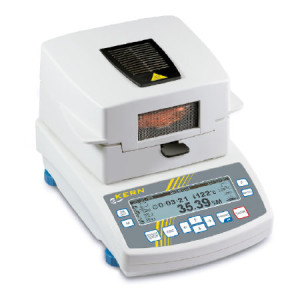Selecting a Moisture Analyzer Drying Process
Infrared moisture analyzers such as the new Kern MLS-C now available from Tovatech use the thermogravimetric drying process to calculate the moisture content of a sample. Also called the loss of weight on drying (LOD) method, the drying process compares the weight of a sample after drying to the weight before drying. The difference is displayed the percent of moisture in the sample. This is a critical quality control step to confirm that commercial bulk drying ovens are performing to specification and that the product meets regulatory or industry standards for moisture content.
Selecting the Moisture Balance Drying Mode
Because products react differently to heat employed during the drying process, laboratory moisture balances can be programmed for different drying modes or drying profiles. These can be classified as standard, rapid, step and gentle. The mode is graphically displayed on the control panel. Here is a general description of each:
- Standard drying, as the name suggests, is used in the majority of cases. The infrared heater immediately raises the sample to the set temperature for moisture analysis to begin.
- The rapid or fast drying mode is programmed when samples have a moisture content of 5% to 15%. At the start temperature immediately increases to a degree exceeding the set drying temperature. The objective is to quickly evaporate excess water in the sample, after which the temperature drops to the set value to complete the moisture analysis exercise.
- Step drying is selected because certain products behave differently during temperature increases over the analysis time. An example is gypsum which has surface water that can be removed relatively easily and trapped water in a crystal structure that takes longer to evaporate. QC personnel can program each step’s time and temperature. Typically this process is used for samples with a moisture content of 15% or more.
- Gentle drying, also called the ramp or soft drying mode allows QC technicians to program slow increases in temperatures over a selected time period. This is because some samples cannot tolerate a sudden rise in temperature and, for example, may develop a film or crust that slows moisture evaporation.
The MLS-C features a graphic display showing the drying mode selected along with other programming details including time, temperature, sample weight, and moisture content. Operators can also call up a drying curve that displays the progress of the drying in real time. This can be used to evaluate the result of the process.
Other Drying Process Criteria
In addition to drying profiles several other factors come into play when conducting moisture analysis. While many of these are developed over time for particular applications, determining the optimum test parameters may call for experimentation on the part of quality control personnel. They then become part of an organization’s standard operating procedures and can be programmed into the unit for call-up as needed. The MLS-C moisture balance, for example, can store up to 100 drying programs.
- Sample weight has a direct bearing on the reproducibility of tests, which means the ability of a moisture balance to display consistent results when weighing under the same conditions. Generally reproducibility is improved when heavier samples are measured (although the drying process takes longer). For the moisture analyzer featured in this post reproducibility is 0.24% for a 2 g sample and 0.04% for a 10 g sample.
- Sample physical properties. Powdered or granular samples react differently than liquids and pastes such as paint and butter. Place samples that may be caramelized or form a surface skin by heat under fiberglass filters. Place liquid samples on fiberglass filters to increase surface area and avoid spattering.
- Sample placement. All samples should be evenly spread on sample plates. Non-liquid samples should be in the form of fine particles, not lumps, in order to help heat transfer.
- Sample color. Light colored samples usually require a higher drying temperature than dark samples because they reflect heat.
- Shut off criteria. Units can be programmed to shut off (a) when a set time period has expired, (b) when weight loss per unit of time falls below an adjustable target value such as mg/second or (c) manually.
The ABCs of Good Moisture Analysis Practices
A. Accurate moisture analysis depends on more than drying modes and the other criteria presented here. User manuals provide detailed instructions on setting up the equipment – specifically calling attention to firm level surfaces away from temperature extremes and external vibrations.
B. Before being used balances must be calibrated using the correct calibration weight, which is generally equal to the maximum weighing range of the equipment – 50 g in this case – and following the easy calibration instructions. Recalibration should be performed on a regular basis.
C. A temperature calibration kit is available to similarly confirm temperature accuracy.
D. Use the tare key to discount the weight of the sample plate and filters before adding samples to the plate.
E. Transfer data to a printer or PC using the RS 232 interface.
F. Clean using a small vacuum or soft brush to remove particles, and a mild soap to wipe down surfaces.
For more information on this check our post on setting up a moisture analyzer. Then contact the scientists at Tovatech for expert advice in selecting and using a moisture analyzer as well as other precision weighing equipment.


